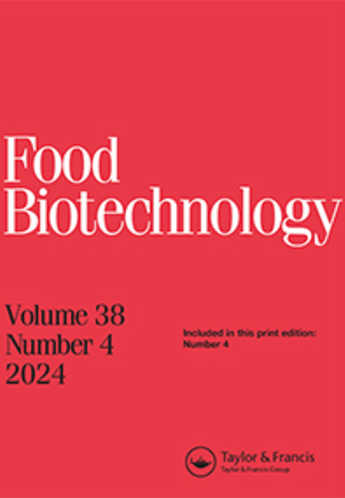Functional expression of recombinant sweet-tasting protein brazzein by Escherichia coli and Bacillus licheniformis
IF 1.6
4区 农林科学
Q4 BIOTECHNOLOGY & APPLIED MICROBIOLOGY
引用次数: 8
Abstract
ABSTRACT Brazzein is an attractive sweetener candidate because of its sugar-like taste, high sweetness, and good stability at high temperature and wide pH range. This study was aimed to express and purify bioactive recombinant brazzein (rBrazzein). The rBrazzein gene was synthesized according to the preferred codons of Bacillus subtilis and successfully expressed in Escherichia coli and Bacillus licheniformis. In E. coli host, lower induction temperature of 30°C increased soluble rBrazzein (Ebrazzein) at high level. In B. licheniformis host, two signal peptides (Sec type and Tat type) were evaluated for the expression of rBarzzein in B. subtilis and B. licheniformis. However, only the Sec-type signal peptide guided the secretion expression of rBrazzein in B. licheniformis. The rBrazzein was expressed steadily and the highest yield reached about 57 mg/L at 36 h by small-scale fermentation. The purification procedure of rBrazzein by B. licheniformis (Bbrazzein) was thus established. Approximately 5 mg/L purified rBrazzein was obtained and the purity was 85%. The conformational state of rBrazzeins was confirmed by circular dichroism. The bioactivities of rBrazzeins were evaluated by sweet taste testing. The Bbrazzein and Ebrazzein were 266 times and 400 times sweeter than sucrose on a weight basis, respectively. The formation of disulfide bonds were both confirmed by LC/MS/MS and MALDI-TOF. The CD analysis indicated that Ebrazzein has a similar secondary structure with natural brazzein, which explained why Ebrazzein had a higher intensity of sweetness. This study demonstrated that B. licheniformis system is useful to produce active recombinant brazzein, and has potential food industry applications.重组甜味蛋白brazzein在大肠杆菌和地衣芽孢杆菌中的功能表达
Brazzein是一种很有吸引力的甜味剂候选,因为它具有类似糖的味道、高甜度、在高温和宽pH范围内具有良好的稳定性。本研究旨在表达和纯化具有生物活性的重组brazzein(rBrazzein)。根据枯草芽孢杆菌的优选密码子合成了rBrazzein基因,并在大肠杆菌和地衣芽孢杆菌中成功表达。在大肠杆菌宿主中,30°C的较低诱导温度使可溶性rBrazzein(Ebrazzein)在较高水平上增加。在地衣芽孢杆菌宿主中,评估了两种信号肽(Sec型和Tat型)在枯草芽孢杆菌和地衣芽孢杆菌中rBarzzein的表达。然而,只有Sec型信号肽引导rBrazzein在地衣芽孢杆菌中的分泌表达。通过小规模发酵,rBrazzein稳定表达,36h时最高产量达到约57mg/L。建立了地衣芽孢杆菌(Bbrazzein)纯化rBrazzein的工艺。获得大约5mg/L纯化的rBrazzein,并且纯度为85%。rBrazzeins的构象状态通过圆二色性得到证实。通过甜味试验评价rBrazzeins的生物活性。以重量为基础,Bbrazzein和Ebrazzein分别比蔗糖甜266倍和400倍。二硫键的形成均通过LC/MS/MS和MALDI-TOF得到证实。CD分析表明,Ebrazzein具有与天然brazzein相似的二级结构,这解释了为什么Ebrazzein具有更高的甜味强度。该研究表明,地衣芽孢杆菌系统可用于生产活性重组brazzein,并具有潜在的食品工业应用前景。
本文章由计算机程序翻译,如有差异,请以英文原文为准。
求助全文
约1分钟内获得全文
求助全文
来源期刊

Food Biotechnology
工程技术-生物工程与应用微生物
CiteScore
3.80
自引率
0.00%
发文量
15
审稿时长
>12 weeks
期刊介绍:
Food Biotechnology is an international, peer-reviewed journal that is focused on current and emerging developments and applications of modern genetics, enzymatic, metabolic and systems-based biochemical processes in food and food-related biological systems. The goal is to help produce and improve foods, food ingredients, and functional foods at the processing stage and beyond agricultural production.
Other areas of strong interest are microbial and fermentation-based metabolic processing to improve foods, food microbiomes for health, metabolic basis for food ingredients with health benefits, molecular and metabolic approaches to functional foods, and biochemical processes for food waste remediation. In addition, articles addressing the topics of modern molecular, metabolic and biochemical approaches to improving food safety and quality are also published.
Researchers in agriculture, food science and nutrition, including food and biotechnology consultants around the world will benefit from the research published in Food Biotechnology. The published research and reviews can be utilized to further educational and research programs and may also be applied to food quality and value added processing challenges, which are continuously evolving and expanding based upon the peer reviewed research conducted and published in the journal.
 求助内容:
求助内容: 应助结果提醒方式:
应助结果提醒方式:


